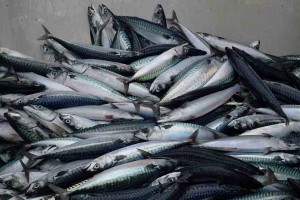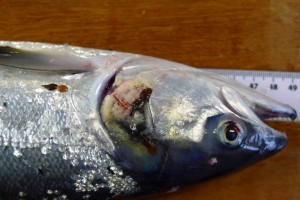Â
As I have written about in an earlier post, the purpose of this research project, SALSEA-Merge, is to understand the life history of the Atlantic Salmon, and to the figure out why they are not returning to the river after their migration out of the rivers and into the sea. This expedition is seeking to understand what is happening to these smolts along their journey through genetic testing, etc. With the knowledge or lack there of about what is actually happening, some of the problems facing these salmon are known. Â
Some of the problems facing these salmon include poor water quality in the rivers, over-harvest, discards of post-smolts as bycatch, sea lice, and lack of food when they reach the sea…to name a few.  The first two are clear, the fish need a good habitat to live in and with development, etc, water quality in the river goes down. This needs to be improved so that the salmon don’t have to battle poor conditions in the beginning (and end) of their lives.Â
Overharvest is also straight-forward. If you take too many fish, there won’t be any spawners left to replenish the populations. Overharvest is one of the largest problems facing the fisheries of the world and the salmon are right there in this losing battle.Â
Â

Two Russian trawlers in the distance
Â
Bycatch is another issue that is key to the decline of many fisheries, but with the salmon, it was a new idea to me. The post-smolts follow a similar migratory path to the shoals of mackerel that are targeted by the large Russian factory trawlers using massive surface trawls to harvest the mackerel in large numbers. While the actual impact of these trawlers is unknown, it is hard to imagine that thousands of post-smolts are not captured in these trawls and processed with the mackerel. The mackerel and post-smolt salmon occupy the same water and having seen the number of mackerel we captured in the sampling trawls, it is hard to imagine that with the size of the trawlers, they are not impacting the population of salmon.Â

Mackerel bycatch from the sampling trawl…100 post-smolts were captured in this trawl…can you imagine how many are taken in the large factory trawls? Â it must be thousands!
The other problems are distinct possibilities as well. Many of the post-smolts we collected had sea lice on them. I learned on the voyage that if a post-smolt has a certain number of sea lice on it, it will certainly die. The sea lice attach themselves to the smolts on their way out of the river past fish farms. Fish farms are the culprit in this game. As the smolts pass, the nauplii (1st stages of development of the sea lice which are copepods, small crustaceans) attach themselves to the smolt and develop into adult sea lice which will remain on the salmon for the remainder of its life. The level of infestation of the sea lice is tremendous and is one of the major problems arising from the use of fish farms to rear salmon.Â

This salmon is infested with sea lice giving way to poor body condition.
Finally, the populations of the small pelagic fish, herring, mackerel, blue whiting, have boomed in the past years impacting the density of zooplankton in the Norwegian Sea. With the increasing populations due to good management of the stocks for maximum abundance, the zooplankton has been grazed heavily leaving a sea nearly devoid of zooplankton. Without zooplankton, our post-smolts have nothing to eat so their body condition is not good and they will not be able to survive without food. This may be a cycle but it is largely unknown at this point…more research must be done.
With all of the potential problems outlined above, it may be something entirely different, but it is hard to imagine how one of our tiny post-smolts can survive its year-long journey in the sea to return to the river to spawn. In fact, given all of the human obstacles we have put in front of them, it is remarkable that any return at all. Â
Â



















